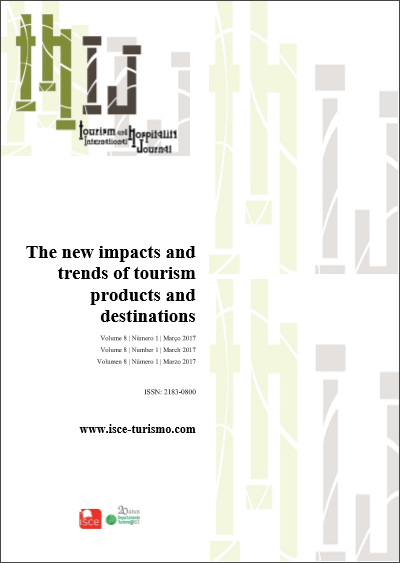Copa do mundo FIFA 2014 no Brasil: Um quadro de impactos nas TICs e nos meios de hospedagem da cidade-sede de Cuiabá / MT
DOI:
https://doi.org/10.57883/thij8(1)2017.30347Keywords:
Accommodation strategies, Hotel private sector, Public authorities, Information and communication technologyAbstract
The tourism sector is an activity that infers a level of organizational structure based on the needs and motivations manifested by the persons. It requires actions aimed at full attendance of supply and demand requirements. Such actions recommend being systematized in strategies conducted by public agencies and institutions that represent private companies. Extending the range of opportunities, the mega-event FIFA World Cup 2014 held in Brazil, despite of great political repercussion, was considered a source of investment in several sectors, including in Means of hosting, technologies used for disclosing and e-commerce. Cuiabá, capital of the state of Mato Grosso, was the smallest among the host cities and received 158,000 tourists during the three games it hosted. This exploratory and descriptive research with quantitative and qualitative approach, used the documentary and field research to collect data. The present study had as main objectives to analyze the legacy provided by the accommodation strategies of the means of hosting and the technological innovations used by the hotel sector. As results, it highlights the creation of new products by pioneer companies and the qualification of the workforce for the sector. However, the insecurity of the business community in relation to the post-event, regarding the significant increase in the number of beds for the city, and the low use of the tools provided by the ICTs, were strengths perceived in the material analyzed. For future research it is suggested the comparison of this data with the other cities that hosted the mega event.
References
Au, N. & Ekiz, E. (2009). Issues and opportunities of Internet hotel marketing in developing countries. Journal of Travel & Tourism Marketing, 26, 225-243.
Bai, B., Hu, C. & Jang, S. (2006) Examining e-relationship marketing features on hotel websites. Journal of Travel & Tourism Marketing, 21(2/3), 33-48.
Banderker, N., & Belle, J. V. (2011). Adoption of mobile technology by public healthcare doctors: A developing country perspective. In M. Gual (Ed.), Healthcare delivery reform and new technologies: Organizational initiatives (pp. 368–383). Hershey, PA: Information Resource Management Association.
Brasil, Ministério do Turismo. (2014). Estudo da Demanda Turística Internacional durante a Copa do Mundo da FIFA 2014. Recovered from
BrasilAlemanha News (2014). SAP. Recovered from http://www.brasilalemanhanews.com.br/Noticia.aspx?id=4070.
Brasil, Infraero (2016). Aeroportos da Infraero esperam 5 milhões de passageiros durante o carnaval. Recovered from http://www.brasil.gov.br/turismo/2016/02/aeroportos-da-infraero-esperam-5-milhoes-de-passageiros-durante-o-carnaval
Brasil, Ministério do Turismo (2012). Sistema Brasileiro de Classificação de Meios de Hospedagem. Recovered from http://www.classificacao.turismo.gov.br/MTUR-classificacao/mtur-site/
Buhalis, D. (1998) Strategic use of information technologies in the tourism industry. Tourism Management, 19(5), 409-421.
Buhalis, D. & Law, R. (2008). Progress in information technology and tourism management: 20 years on and 10 years after the Internet - The state of e Tourism research. Tourism Management, 29, 609-623.
Camisón, C.; Monfort-Mir, V. (2012). Measuring innovation in tourism from the Schumpeterian and the dynamic-capabilities perspectives. Tourism Management, 33, 776-789.
Castelli, G. (2003). Administração hoteleira (9. ed.). Caxias do Sul: Educs.
Castells, M.(1999) A sociedade em rede - A era da informação: economia, sociedade e cultura. São Paulo: Paz e Terra.
Chappelet, J. (2012). Mega Sporting Event Legacies: A Multifaceted Concept. Portal De Revistas Científicas Complutenses, Madrid, Dez. 2012. Recovered from http://Revistas.Ucm.Es/Index.Php/Pade/Article/View/41096>.
Ecommerce News. (2015). Recovered from http://ecommercenews.com.br/noticias/pesquisas-noticias/m-commerce-ja-representa-10-das-transacoes-online-diz-criteo
FGV Projetos (2014). Pesquisa de demanda turística doméstica na Copa do Mundo da FIFA no Brasil – 2014. Recovered from http://www.dadosefatos.turismo.gov.br/export/sites/default/dadosefatos/outros_estudos/downloads_outrosestudos/Estudos_da_Demanda_Domestica_Brasil_Copa_2014_1.pdf
Fotis. J., Buhalis. D., & Rossides. N. (2012). Social media use and impact during the holiday travel planning process. Recovered from
Frey, S., Schegg, R. & Steiner, T. (2002) Benchmarking Internet use for the marketing of swiss hotels. Lausanne Institute for Hospitality Research (LIHR) - Copyright of Information Communication Technologies in Tourism, p. 294-302.
Hosteltur. E-comunicación para el turismo del futuro. Recovered from http://static.hosteltur.com/web/uploads/2013/01/Hosteltur_224_Internet_y_turismo.pdf
Izquierdo-Yusta, A. & Schultz, R. J. (2011). Understanding the effect of Internet convenience on intention to purchase via the Internet. Journal of Marketing Development and Competitiveness, 5, 4.
Kim, J., Connolly, D. J., & Blum, S. (2014). Mobile technology: An exploratory study of hotel managers. International Journal of Hospitality & Tourism Administration, 15, 417-446.
Kim, T. G., Lee, J. H., & Law, R. (2008). An empirical examination of the acceptance behavior of hotel front office systems: An extended technology acceptance model. Tourism Management, 29(3), 500–513.
Lim, W. M. (2008). Regression analysis of Internet technologies adoption factors and business performance of UK independent hoteliers. Tourism and Hospitality Planning & Development, 5 (3), 233-245.
Lin, Y; Lee, J. (2010). The impacts of the online reservation system in London City hotels. Journal of Hospitality Marketing & Management, 19, 82-96.
Litvin, S., Goldsmith, R. & Pan, B. (2008) Electronic word-of-mouth in hospitality and tourism management. Tourism Management, 29, 458-468.
Manap, K., Adzharud in, N. (2013). The role of user generated contented (UGC) in social media for tourism sector, 52-58.
O’Connor, P. (2001) Distribuição da informação eletrônica em turismo e hotelaria. Porto Alegre: Bookman.
O’Connor, P; Frew (2002). A. Expert perceptions on the future on hotel electronic distribution: Expert and industry perspectives. Cornell Hotel and Restaurant Administration Quarterly, 43(3), 33-45.
Singh, S. & Diamond, S. (2012). Social Media Marketing for Dummies, 2nd edition. New Jersey: John Wiley & Sons, Inc.
TecnoHotel News. (2013). Que es el CRM hotelero? Recovered from http://www.tecnohotelnews.com/2013/04/que-el-social-crm-hotelero
Viglia, G., Minazzi, R. & Buhalis, D. (2016). The influence of e-word-of-mouth on hotel occupancy rate. International Journal of Contemporary Hospitality Management. 28(9), 2035-2051
Yeh, R., Leong, J. K. Blecher, L. & Hu, W. (2005) Analysis of e-commerce and information technology applications in hotels: Business travelers' perceptions. Asia Pacific Journal of Tourism Research. 10(1), 59-83.
Downloads
Published
How to Cite
Issue
Section
License
Copyright (c) 2023 This work is licensed under a Creative Commons - Attribution 4.0 International (CC BY 4.0)

This work is licensed under a Creative Commons Attribution 4.0 International License.
This work is published under the Creative Commons Attribution 4.0 International License.






